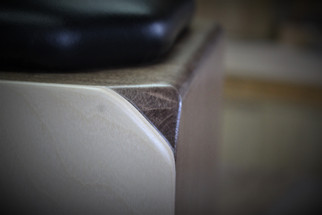Posted by Steve Head on 3rd Apr 2023
What Are The Characteristics of A Mahogany Cajon
Mahogany is a popular choice for cajon drums due to its unique tonal properties and durability. This tropical hardwood has been used in musical instrument construction for centuries and is known for its rich, warm sound that can provide depth and character to any cajon.
One of the key benefits of using mahogany as a drum building material is its tonal qualities. Mahogany has a low-midrange frequency response, which means that it provides a warm, full-bodied sound that can add depth and richness to any drum. This is particularly useful for percussionists who are looking to create a warm, vintage sound, as mahogany cajons can add a unique character and tonality to any recording or live performance.
Mahogany is also a durable wood that can withstand the rigors of frequent use and travel. This makes it an ideal choice for drummers who are looking for a reliable, long-lasting cajon drum that can withstand the demands of heavy playing and touring. The wood is also resistant to warping and cracking, which means that it will remain stable and consistent over time.
Another benefit of using mahogany as a cajon building material is its versatility. Mahogany can be used to create a wide range of cajon types, from snare cajons to bass cajons. The wood is also easy to work with, which means that it can be shaped and crafted into a variety of designs and sizes. This makes it an ideal choice for builders who are looking to create custom, one-of-a-kind cajons that are tailored to their specific needs and preferences.
There are a few different types of mahogany that are commonly used in drum building, including Honduran, African, and Sapele mahogany. Each of these types of mahogany has its own unique tonal characteristics, which means that drum builders can choose the type of mahogany that best suits their desired sound and playing style.
Honduran mahogany is known for its warmth and depth, and is often used in high-end cajons due to its superior tonal qualities. African mahogany, on the other hand, has a brighter, more focused sound that is ideal for snare cajons and hybrid cajons. Sapele mahogany is a newer variety of mahogany that is gaining popularity in drum building due to its similar tonal qualities to Honduran mahogany, but at a more affordable price point.
While there are many benefits to using mahogany as a drum building material, there are also some potential downsides to consider. For example, mahogany cajons can be heavier than drums made from other materials, which can make them more difficult to transport. Additionally, some drummers may find that the warm, rich tone of mahogany does not suit their playing style or the type of music they are playing.
In conclusion, mahogany is a popular choice for Cajon builders due to its unique tonal properties, durability, and versatility. Whether you're looking to create a vintage-style drum kit or a custom-designed set that is tailored to your specific needs, mahogany can provide a warm, rich sound that is ideal for a wide range of musical styles and settings. While there are some potential downsides to using mahogany as a drum building material, the benefits of this unique hardwood make it a top choice for many drummers and cajon builders around the world.
As an Amazon Associate, I earn from qualifying purchases. This means that if you click on the link and make a purchase, I may receive a small commission at no extra cost to you. This helps support my work in providing quality content. Thank you for your support!
Check out my Blog Post Why You Should Consider Playing a Cajon in Drum Circles.


